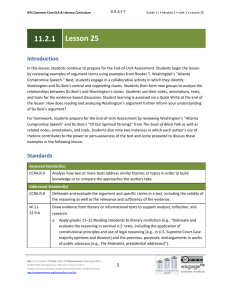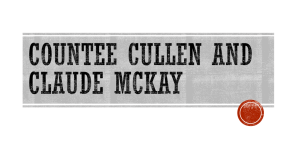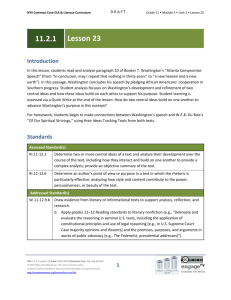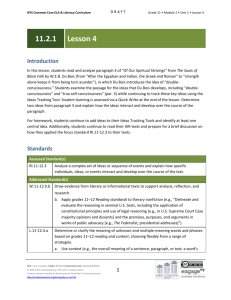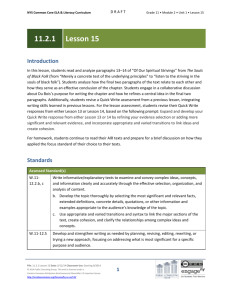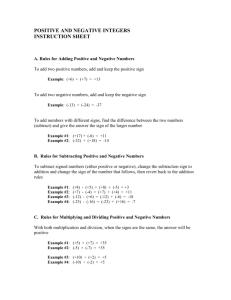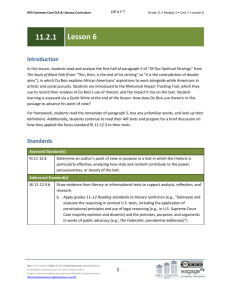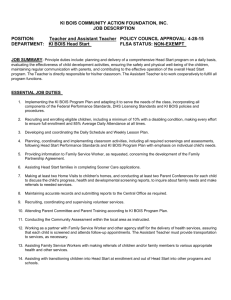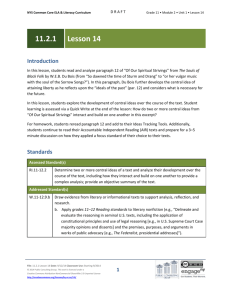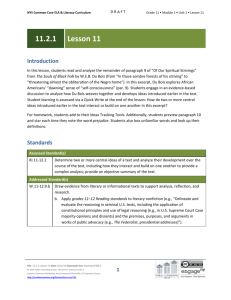Grade 11 ELA Module 2, Unit 1, Lesson 9
advertisement
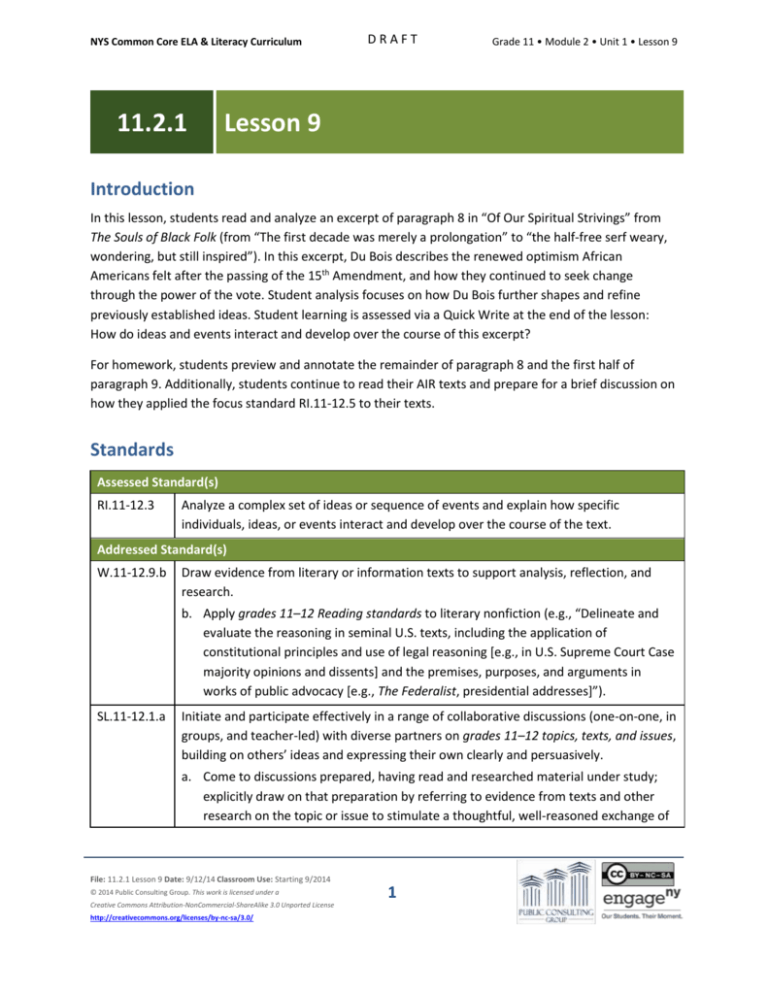
NYS Common Core ELA & Literacy Curriculum 11.2.1 DRAFT Grade 11 • Module 2 • Unit 1 • Lesson 9 Lesson 9 Introduction In this lesson, students read and analyze an excerpt of paragraph 8 in “Of Our Spiritual Strivings” from The Souls of Black Folk (from “The first decade was merely a prolongation” to “the half-free serf weary, wondering, but still inspired”). In this excerpt, Du Bois describes the renewed optimism African Americans felt after the passing of the 15th Amendment, and how they continued to seek change through the power of the vote. Student analysis focuses on how Du Bois further shapes and refine previously established ideas. Student learning is assessed via a Quick Write at the end of the lesson: How do ideas and events interact and develop over the course of this excerpt? For homework, students preview and annotate the remainder of paragraph 8 and the first half of paragraph 9. Additionally, students continue to read their AIR texts and prepare for a brief discussion on how they applied the focus standard RI.11-12.5 to their texts. Standards Assessed Standard(s) RI.11-12.3 Analyze a complex set of ideas or sequence of events and explain how specific individuals, ideas, or events interact and develop over the course of the text. Addressed Standard(s) W.11-12.9.b Draw evidence from literary or information texts to support analysis, reflection, and research. b. Apply grades 11–12 Reading standards to literary nonfiction (e.g., “Delineate and evaluate the reasoning in seminal U.S. texts, including the application of constitutional principles and use of legal reasoning [e.g., in U.S. Supreme Court Case majority opinions and dissents] and the premises, purposes, and arguments in works of public advocacy [e.g., The Federalist, presidential addresses]”). SL.11-12.1.a Initiate and participate effectively in a range of collaborative discussions (one-on-one, in groups, and teacher-led) with diverse partners on grades 11–12 topics, texts, and issues, building on others’ ideas and expressing their own clearly and persuasively. a. Come to discussions prepared, having read and researched material under study; explicitly draw on that preparation by referring to evidence from texts and other research on the topic or issue to stimulate a thoughtful, well-reasoned exchange of File: 11.2.1 Lesson 9 Date: 9/12/14 Classroom Use: Starting 9/2014 © 2014 Public Consulting Group. This work is licensed under a Creative Commons Attribution-NonCommercial-ShareAlike 3.0 Unported License http://creativecommons.org/licenses/by-nc-sa/3.0/ 1 NYS Common Core ELA & Literacy Curriculum DRAFT Grade 11 • Module 2 • Unit 1 • Lesson 9 ideas. L.11-12.4.a Determine or clarify the meaning of unknown and multiple-meaning words and phrases based on grades 11–12 reading and content, choosing flexibly from a range of strategies. a. Use context (e.g., the overall meaning of a sentence, paragraph, or text; a word’s position or function in a sentence) as a clue to the meaning of a word or phrase. Assessment Assessment(s) Student learning is assessed via a Quick Write at the end of the lesson. Students respond to the following prompt, citing textual evidence to support analysis and inferences drawn from text. How do ideas and events interact and develop over the course of this excerpt? High Performance Response(s) A High Performance Response should: Identify the ideas and events in this excerpt (e.g., Du Bois discusses the following ideas: o Emancipation did not provide African Americans with the freedom that they sought. o African Americans began to hope that political power would help them to change their situation and attain freedom. Du Bois discusses the following events: o “[t]he holocaust of war” (par. 8) o “the terrors of the Ku-Klux Klan” (par. 8) o “the lies of the carpet-baggers” (par. 8) o “the disorganization of industry“ (par. 8) o “the Fifteenth Amendment” (par. 8) o “the revolution of 1876” (par. 8) Explain how the ideas and events interact and develop over the course of the excerpt (e.g., Du Bois cites four events that happened after Emancipation: the horrible aftermath of the war, the atrocities committed by the Ku-Klux Klan, the exploitation of the South by northern “carpetbaggers” (par. 8), and the collapse of the Southern economy. The destruction and terror of these events further develops the idea that Emancipation did not provide African Americans with the freedom that they sought. Du Bois then explains the hope that came with the 15th Amendment. This “powerful means” (par. 8) of the right to vote gave African Americans hope that, through political power, they would have a way to change their situation and attain true freedom.). File: 11.2.1 Lesson 9 Date: 9/12/14 Classroom Use: Starting 9/2014 © 2014 Public Consulting Group. This work is licensed under a Creative Commons Attribution-NonCommercial-ShareAlike 3.0 Unported License http://creativecommons.org/licenses/by-nc-sa/3.0/ 2 NYS Common Core ELA & Literacy Curriculum DRAFT Grade 11 • Module 2 • Unit 1 • Lesson 9 Vocabulary Vocabulary to provide directly (will not include extended instruction) prolongation (n.) – the act of lengthening out in time; extending the duration of boon (n.) – something to be thankful for; blessing; benefit elude (v.) – to avoid or escape by speed, cleverness, or trickery will-o’-the-wisp (n.) – a goal that cannot be reached holocaust (n.) – a great or complete devastation or destruction; any mass slaughter or reckless destruction of life serf (n.) – a person in a condition of servitude; a slave watchword (n.) – a rallying cry attainment (n.) – the act of reaching, achieving, or accomplishing; gaining; obtaining enfranchised (v.) – gave (someone) the legal right to vote renewed (v. ) – revived; reestablished zeal (n.) – a strong feeling of interest and enthusiasm that makes someone very eager or determined to do something Vocabulary to teach (may include direct word work and/or questions) endowed (v.) – provided with something freely or naturally Additional vocabulary to support English Language Learners (to provide directly) decade (n.) – a period of 10 years merely (adv.) – only, just (used to say that someone or something is small, unimportant, etc.) grasp (n.) – the distance that can be reached by your arms and hands grasp (v.) – to understand (something that is complicated or difficult contradictory (adj.) – involving or having information that disagrees with other information ballot (n.) – a ticket or piece of paper used to vote in an election visible (adj.) – able to be seen partially (adv.) – somewhat but not completely; to some extent or in some degree revolution (n.) – a sudden, extreme, or complete change in the way people live, work, etc. File: 11.2.1 Lesson 9 Date: 9/12/14 Classroom Use: Starting 9/2014 © 2014 Public Consulting Group. This work is licensed under a Creative Commons Attribution-NonCommercial-ShareAlike 3.0 Unported License http://creativecommons.org/licenses/by-nc-sa/3.0/ 3 NYS Common Core ELA & Literacy Curriculum DRAFT Grade 11 • Module 2 • Unit 1 • Lesson 9 Lesson Agenda/Overview Student-Facing Agenda % of Lesson Standards & Text: Standards: RI.11-12.3, W.11-12.9.b, SL.11-12.1.a, L.11-12.4.a Text: The Souls of Black Folk by W.E.B. Du Bois, Chapter 1: “Of Our Spiritual Strivings,” paragraph 8 Learning Sequence: 1. 2. 3. 4. 5. 6. Introduction of Lesson Agenda Homework Accountability Masterful Reading Reading and Discussion Quick Write Closing 1. 2. 3. 4. 5. 6. 10% 15% 5% 55% 10% 5% Materials Student copies of the Rhetorical Impact Tracking Tool (refer to 11.2.1 Lesson 6)—students may need additional blank copies Student copies of the Ideas Tracking Tool (refer to 11.2.1 Lesson 2)—students may need additional blank copies Student copies of the Short Response Rubric and Checklist (refer to 11.2.1 Lesson 1) Learning Sequence How to Use the Learning Sequence Symbol Type of Text & Interpretation of the Symbol 10% no symbol Percentage indicates the percentage of lesson time each activity should take. Plain text indicates teacher action. Bold text indicates questions for the teacher to ask students. Italicized text indicates a vocabulary word. Indicates student action(s). Indicates possible student response(s) to teacher questions. Indicates instructional notes for the teacher. File: 11.2.1 Lesson 9 Date: 9/12/14 Classroom Use: Starting 9/2014 © 2014 Public Consulting Group. This work is licensed under a Creative Commons Attribution-NonCommercial-ShareAlike 3.0 Unported License http://creativecommons.org/licenses/by-nc-sa/3.0/ 4 NYS Common Core ELA & Literacy Curriculum DRAFT Grade 11 • Module 2 • Unit 1 • Lesson 9 Activity 1: Introduction of Lesson Agenda 10% Begin by reviewing the agenda and assessed standard for this lesson: RI.11-12.3. Students continue reading paragraph 8 of Du Bois’s “Of Our Spiritual Strivings.” Student analysis focuses on how the ideas and events in this excerpt further shape and refine previously established ideas. Students look at the agenda. Activity 2: Homework Accountability 15% Instruct students to take out their responses to the previous lesson’s homework assignment. (Based on your analysis in this lesson, add at least two ideas introduced in paragraphs 6–7 to your Ideas Tracking Tool and determine one central idea. Additionally, conduct a brief search for information about the following groups and events that Du Bois mentions in paragraph 8: the Ku Klux Klan, carpet-baggers, Reconstruction, the 15th Amendment to the U.S. Constitution, and “the revolution of 1876,” also referred to as “The Compromise of 1877.”) Instruct students to Turn-and-Talk in pairs about the additions they made to their Ideas Tracking Tools for the previous lesson’s homework. See the Model Ideas Tracking Tool. Instruct student pairs to share a central idea they identified from paragraphs 6–7. Emancipation did not provide complete or total freedom to African Americans. Instruct student pairs to discuss the findings of their brief searches into the Ku Klux Klan, carpet-baggers, Reconstruction, the 15th Amendment to the U.S. Constitution, and “the revolution of 1876.” Student responses may include: o o o o The Ku Klux Klan (KKK) is an organization known for its hate and terrorist activities against African Americans. Founded in 1866, the KKK spread to almost every Southern state by 1870 and worked to resist policies aimed at establishing equality. Carpet-baggers was a term used to refer to Northerners who traveled to the South following the Civil War to take advantage of the instability in the region for their own personal gain. The term is still used today to describe someone who goes to an area to exploit it. Reconstruction refers to the era immediately following the Civil War during which the nation worked to reincorporate and rebuild the South. The 15th Amendment to the U.S. Constitution gave African American men the right to vote in 1870, several years after the Emancipation Proclamation. File: 11.2.1 Lesson 9 Date: 9/12/14 Classroom Use: Starting 9/2014 © 2014 Public Consulting Group. This work is licensed under a Creative Commons Attribution-NonCommercial-ShareAlike 3.0 Unported License http://creativecommons.org/licenses/by-nc-sa/3.0/ 5 NYS Common Core ELA & Literacy Curriculum o DRAFT Grade 11 • Module 2 • Unit 1 • Lesson 9 “[T]he revolution of 1876,” though not technically the title of an event, refers to the end of the Reconstruction era, and the compromise reached between newly elected President Rutherford B. Hayes and the Southern states, which saw the withdrawal of all federal troops from the South in exchange for the certification of his election. It was a time when the South worked to re-establish white supremacy. Lead a brief whole-class discussion of student responses. This research and discussion activity supports students’ engagement with SL.11-12.1.a, which addresses preparing for discussions and drawing on that preparation by referring to evidence from research on the topic. Activity 3: Masterful Reading 5% Have students listen to a masterful reading of paragraph 8 from “Of Our Spiritual Strivings” (from “The first decade was merely a prolongation” to “the half-free serf weary, wondering, but still inspired”). Instruct students to listen for key events, individuals, and ideas that Du Bois identifies or highlights. Students follow along, reading silently. Differentiation Consideration: Consider posting or projecting the following guiding question to support students in their reading throughout this lesson: What gave African Americans hope after a “vain search for freedom” (par. 8)? Activity 4: Reading and Discussion 55% Instruct students to form small groups. Post or project each set of questions below for students to discuss. Instruct students to continue to annotate the text as they read and discuss. This annotation supports students’ engagement with W.11-12.9.b, which addresses the use of textual evidence in writing. Instruct students to take out their Rhetorical Impact Tracking Tools and Ideas Tracking Tools. Instruct students to record their analysis of how Du Bois develops ideas and effectively uses rhetoric as they read and analyze this lesson’s text excerpt. Instruct student groups to read from “The first decade was merely a prolongation” to “no new watchword beyond the old cry for freedom” and answer the following questions before sharing out with the class. Provide students with the following definitions: prolongation means “the act of lengthening out in time; extending the duration of,” boon means “something to be thankful for; blessing; benefit,” elude means File: 11.2.1 Lesson 9 Date: 9/12/14 Classroom Use: Starting 9/2014 © 2014 Public Consulting Group. This work is licensed under a Creative Commons Attribution-NonCommercial-ShareAlike 3.0 Unported License http://creativecommons.org/licenses/by-nc-sa/3.0/ 6 NYS Common Core ELA & Literacy Curriculum DRAFT Grade 11 • Module 2 • Unit 1 • Lesson 9 “to avoid or escape by speed, cleverness, or trickery,” will-o’-the-wisp means “a goal that cannot be reached,” holocaust means “a great or complete devastation or destruction; any mass slaughter or reckless destruction of life,” serf means “a person in a condition of servitude; a slave” and watchword means “a rallying cry.” Students write the definitions of prolongation, boon, elude, will-o’-the-wisp, holocaust, serf, and watchword on their copies of the text or in a vocabulary journal. Differentiation Consideration: Consider providing students with the following definitions: decade means “a period of 10 years,” merely means “only, just (used to say that someone or something is small, unimportant, etc.),” grasp means “the distance that can be reached by your arms and hands” and can also mean ““to understand (something that is complicated or difficult),” and contradictory means “involving or having information that disagrees with other information.” Students write the definitions of decade, merely, grasp, and contradictory on their copies of the text or in a vocabulary journal. Based on your analysis in previous lessons and the historical events researched for homework, to what does “[t]he first decade” refer? “The first decade” refers to the 10 years immediately following Emancipation. How does Du Bois connect the first sentence of paragraph 8 to the end of paragraph 7? What does this idea demonstrate about African Americans’ experience of freedom? Du Bois connects the two paragraphs by describing the passage of time since Emancipation. The last sentence of paragraph 7 begins with “Whatever of good may have come in these years of change, the shadow of a deep disappointment rests upon the Negro people.” Du Bois then begins paragraph 8 with the statement “The first decade was merely a prolongation.” This connection demonstrates that despite the passing of time since Emancipation, African Americans have yet to experience complete “freedom” (par. 8). What makes the search for freedom “vain”? The search for freedom is “vain” because it remains unsuccessful and out of reach. Du Bois writes that freedom “seemed ever barely to elude their grasp,—like a tantalizing will-o’-thewisp.” How does the metaphor of “the headless host” further develop “the vain search for freedom”? The metaphor of the “headless host” further develops the idea that African Americans’ “search for freedom” is “vain” or useless, because it compares African Americans to a being without a head, unable to see or “grasp” the freedom that is almost within reach. File: 11.2.1 Lesson 9 Date: 9/12/14 Classroom Use: Starting 9/2014 © 2014 Public Consulting Group. This work is licensed under a Creative Commons Attribution-NonCommercial-ShareAlike 3.0 Unported License http://creativecommons.org/licenses/by-nc-sa/3.0/ 7 NYS Common Core ELA & Literacy Curriculum DRAFT Grade 11 • Module 2 • Unit 1 • Lesson 9 Why does “the bewildered serf” have “no new watchword beyond the old cry for freedom”? The “bewildered serf” has “no new watchword,” because each event or group of people that Du Bois mentions (“[t]he holocaust of war,” “the Ku-Klux Klan,” “carpet-baggers, the disorganization of industry”) prevented prosperity, peace, and equality for African Americans in the Southern states following the Civil War, and so kept their “search for freedom” unsuccessful. Differentiation Consideration: Consider explaining that the phrase “the disorganization of industry” refers to the era known as Reconstruction, which students researched and discussed in the Homework Accountability activity. What is the impact of Du Bois’s use of the phrase “bewildered serf”? Because serf is another word for slave and “bewildered” implies a state of confusion, the phrase “bewildered serf” (par. 8) reinforces Du Bois’s idea that African Americans were uncertain how to proceed after Emancipation because the aftermath of war prevented them from achieving the “ideal” (par. 7) of freedom they had hoped would follow from the legal end of slavery. Lead a brief whole-class discussion of student responses. Remind students to record relevant notes and ideas from this excerpt on their Ideas Tracking Tools and their Rhetorical Impact Tracking Tools. Instruct student groups to read from “As the time flew, however, he began to grasp a new idea” to “the half-free serf weary, wondering, but still inspired” and discuss the following questions before sharing out with the class. Provide students with the following definitions: attainment means “the act of reaching, achieving, or accomplishing; gaining; obtaining,” enfranchised means “gave (someone) the legal right to vote,” renewed means “revived; reestablished,” and zeal means “a strong feeling of interest and enthusiasm that makes someone very eager or determined to do something.” Students write the definitions of attainment, enfranchised, renewed, and zeal on their copies of the text or in a vocabulary journal. Differentiation Consideration: Consider providing students with the following definitions: ballot means “a ticket or piece of paper used to vote in an election,” visible means “able to be seen,” partially means “somewhat but not completely; to some extent or in some degree,” and revolution means “a sudden, extreme, or complete change in the way people live, work, etc.” Students write the definitions of ballot, visible, partially, and revolution on their copies of the text or in a vocabulary journal. What connection does Du Bois establish between “gaining and perfecting … liberty” and “powerful means”? File: 11.2.1 Lesson 9 Date: 9/12/14 Classroom Use: Starting 9/2014 © 2014 Public Consulting Group. This work is licensed under a Creative Commons Attribution-NonCommercial-ShareAlike 3.0 Unported License http://creativecommons.org/licenses/by-nc-sa/3.0/ 8 NYS Common Core ELA & Literacy Curriculum DRAFT Grade 11 • Module 2 • Unit 1 • Lesson 9 Because “[t]he ideal of liberty” had “elude[d] their grasp,” Du Bois recognizes that freedom for African Americans would require “powerful means,” or the tools and ability, to attain it. The “powerful means” to which Du Bois refers is the right to vote, which “the Fifteenth Amendment gave [them].” If students struggle with this analysis, consider posing the following scaffolding question: What is the “new idea” African Americans began to “grasp”? The “new idea” was the realization that the freedom African Americans still sought could be attained through “the ballot” and the right to vote. Compare the two ways in which Du Bois describes “the ballot” in the sentence beginning “The ballot, which before he had.” Du Bois describes “the ballot” (par. 8) (the right to vote) before the 15th Amendment “as a visible sign of freedom” (par. 8) and after the 15th Amendment “as the chief means of gaining and perfecting … liberty” (par. 8). Perception of the right to vote shifts in this sentence from being symbolic or a “sign” to being a tool or “means” (par. 8) that African Americans can use to achieve their “ideal” (par. 7) of freedom. How does Du Bois’s description of liberty as “partially endowed” further develop his point of view? By describing liberty as only “partially endowed” after the Civil War, Du Bois reinforces his point of view that African Americans were granted incomplete freedom through Emancipation. What could endowed mean in this sentence? Endowed could mean given or provided. Consider drawing students’ attention to their application of standard L.11-12.4.a through the process of determining the meaning of a word through context. What effect does Du Bois create through the questions that he asks in this excerpt? Student responses may include: o o Du Bois builds a sense of excitement and anticipation through a series of questions, such as “Had not votes made war and emancipated millions,” because he does not wait for the answer to these questions, and asks several questions in rapid succession. Du Bois’s use of questions emphasizes “a million black men[’s]” excitement or “renewed zeal” that came from their belief in “the ballot” as a tool that could help them to achieve political power and change their lives. File: 11.2.1 Lesson 9 Date: 9/12/14 Classroom Use: Starting 9/2014 © 2014 Public Consulting Group. This work is licensed under a Creative Commons Attribution-NonCommercial-ShareAlike 3.0 Unported License http://creativecommons.org/licenses/by-nc-sa/3.0/ 9 NYS Common Core ELA & Literacy Curriculum DRAFT Grade 11 • Module 2 • Unit 1 • Lesson 9 Explain to students that the questions Du Bois poses are an example of rhetorical questions, which are “questions that a speaker or writer asks but does not necessarily expect the reader or listener to answer directly.” Rather, rhetorical questions are meant to cause the reader or listener to think. Instruct students to use their Rhetorical Impact Tracking Tools to record this definition and example of rhetorical questions. Students were introduced to the term rhetorical question in 11.1.3 Lesson 3. How does the idea of “vot[ing] themselves into the kingdom” further develop the idea of “gaining and perfecting … liberty”? “[V]ot[ing] themselves into the kingdom” would provide African Americans with a share of the political power that “the other world” (par. 1) currently possesses. Once African Americans gained political power, they could use “the ballot” as a “means” to “gain[] and perfect[] [their] liberty” (par. 8). Remind students of their work with the metaphor of the “kingdom of culture” (par. 5) in 11.2.1 Lesson 6. Why were former slaves “weary, wondering, but still inspired”? Former slaves were “weary” and “wondering,” because their Emancipation and “enfranchise[ment]” did not bring the freedom they sought, and they were suffering the negative effects of “the terrors of the Ku-Klux Klan, the lies of the carpet-baggers, the disorganization of industry” and “the revolution of 1876.” They were “inspired” because they still believed that the “power” of the vote would give them true freedom. Differentiation Consideration: If students struggle with this analysis, consider posing the following scaffolding question: Who is the “half-free serf”? Why is the serf “half-free”? Du Bois describes African Americans as “half-free” because their freedom has only been “partially endowed” through the Civil War and Emancipation. Lead a brief whole-class discussion of student responses. Remind students to record relevant notes and ideas from this excerpt on their Ideas Tracking Tools and their Rhetorical Impact Tracking Tools. Activity 5: Quick Write 10% Instruct students to respond briefly in writing to the following prompt: How do ideas and events interact and develop over the course of this excerpt? File: 11.2.1 Lesson 9 Date: 9/12/14 Classroom Use: Starting 9/2014 © 2014 Public Consulting Group. This work is licensed under a Creative Commons Attribution-NonCommercial-ShareAlike 3.0 Unported License http://creativecommons.org/licenses/by-nc-sa/3.0/ 10 NYS Common Core ELA & Literacy Curriculum DRAFT Grade 11 • Module 2 • Unit 1 • Lesson 9 Instruct students to look at their annotations to find evidence. Ask students to use this lesson’s vocabulary wherever possible in their written responses and to develop the topic through the use of well-chosen, relevant, and sufficient evidence that is appropriate to the audience’s knowledge of the topic. Remind students to use their Short Response Rubric and Checklist to guide their written responses. Students listen and read the Quick Write prompt. Display the prompt for students to see or provide the prompt in hard copy. Consider assessing W.11-12.2.b using the relevant portion of the 11.2.1 Text Analysis Rubric and Checklist. Transition to the independent Quick Write. Students independently answer the prompt using evidence from the text. See the High Performance Response at the beginning of the lesson. Activity 6: Closing 5% Display and distribute the homework assignment. For homework, instruct students to preview and annotate the remainder of paragraph 8 and the first half of paragraph 9 (from “Slowly but steadily, in the following years” to “to the youth with dawning self-consciousness, self-realization, self-respect”). Also for homework, students should continue to read their AIR texts through the lens of the focus standard RI.11-12.5 and prepare for a brief 3–5 minute discussion of their texts based on that standard. Students who are reading literature should read through the lens of a focus standard of their choice. Students follow along. Homework Preview and annotate the remainder of paragraph 8 and the first half of paragraph 9 (from “Slowly but steadily, in the following years” to “to the youth with dawning self-consciousness, self-realization, selfrespect”). Also, continue reading your AIR text through the lens of the focus standard RI.11-12.5 and prepare for a 3–5 minute discussion of your text based on that standard. File: 11.2.1 Lesson 9 Date: 9/12/14 Classroom Use: Starting 9/2014 © 2014 Public Consulting Group. This work is licensed under a Creative Commons Attribution-NonCommercial-ShareAlike 3.0 Unported License http://creativecommons.org/licenses/by-nc-sa/3.0/ 11 DRAFT NYS Common Core ELA & Literacy Curriculum Grade 11 • Module 2 • Unit 1 • Lesson 9 Model Rhetorical Impact Tracking Tool Name: Class: Date: Directions: Use this tool to track the rhetorical devices you encounter in the text, as well as examples of these devices and their definitions. Be sure to note the rhetorical effect of each device in the text. Text: “Of Our Spiritual Strivings” from The Souls of Black Folk by W.E.B. Du Bois RI.11-12.6: Determine an author’s point of view or purpose in a text in which the rhetoric is particularly effective, analyzing how style and content contribute to the power, persuasiveness, or beauty of the text. Rhetoric: The specific techniques that writers or speakers use to create meaning in a text, enhance a text or a speech, and in particular, persuade readers or listeners. Point of View (an author’s opinion, attitude, or judgment): Purpose (an author’s reason for writing): Rhetorical device and definition Examples of the rhetorical device in the text (with paragraph or page reference) Rhetorical effect (power, persuasiveness, beauty, point of view, purpose) Rhetorical Question: A question that a speaker or writer asks but does not necessarily expect the reader or listener to answer directly “And why not? Had not votes made war and emancipated millions? Had not votes enfranchised the freedmen? Was anything impossible to a power that had done all this?” (par. 8) These rhetorical questions contribute to the power of the text because they create the effect of excitement and eager anticipation, and demonstrate the hope African Americans placed in the right to vote. File: 11.2.1 Lesson 9 Date: 9/12/14 Classroom Use: Starting 9/2014 © 2014 Public Consulting Group. This work is licensed under a Creative Commons Attribution-NonCommercial-ShareAlike 3.0 Unported License http://creativecommons.org/licenses/by-nc-sa/3.0/ 12 DRAFT NYS Common Core ELA & Literacy Curriculum Grade 11 • Module 2 • Unit 1 • Lesson 9 Model Ideas Tracking Tool Name: Class: Date: Directions: Identify the ideas that you encounter throughout the text. Trace the development of those ideas by noting how the author introduces, develops, or refines these ideas in the texts. Cite textual evidence to support your work. Text: “Of Our Spiritual Strivings” from The Souls of Black Folk by W.E.B. Du Bois Paragraph # Ideas Notes and Connections 6 Freedom as a “divine event” By connecting “Freedom” to the “divine” (par. 6), Du Bois relates the power of freedom to the power of the “divine” (par. 6). African Americans looked to “Freedom” as a solution to their problems, or the “end of all doubt and disappointment” (par. 6). 7 Emancipation did not bring complete freedom to African Americans. Du Bois writes “The Nation has not yet found peace from its sins; the freedman has not yet found in freedom his promised land” (par. 7) to explain the realization that Emancipation did not bring complete freedom to African Americans because the Nation still faced the ghost of slavery in the form of oppression, or the “vastest social problem” (par. 6). 6 “swarthy spectre” Du Bois refers to “the swarthy spectre” to acknowledge that the ghost of slavery still exists, and prevents African Americans from being truly free (par. 6). This “swarthy spectre” represents the “vastest social problem” that faces “the Nation” (par. 6). 8 The “search for freedom” has been “vain.” Du Bois states “[t]he first decade was merely a prolongation of the vain search for freedom” (par. 8). Despite the passage of time since Emancipation, African Americans have yet to experience “freedom,” despite their ongoing “search” (par. 8) for this “ideal” (par. 7). 8 African Americans realize that political power is a means to attain liberty. African Americans realize that “the ballot” (par. 8) is more than a symbol of freedom. Their shifting perception of “the ballot” illustrates how African Americans came to see “the ballot” as the “chief means of gaining and perfecting … liberty” (par. 8), or achieving their long-sought “ideal” (par. 7) of freedom. File: 11.2.1 Lesson 9 Date: 9/12/14 Classroom Use: Starting 9/2014 © 2014 Public Consulting Group. This work is licensed under a Creative Commons Attribution-NonCommercial-ShareAlike 3.0 Unported License http://creativecommons.org/licenses/by-nc-sa/3.0/ 13
